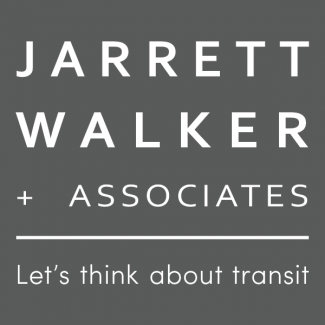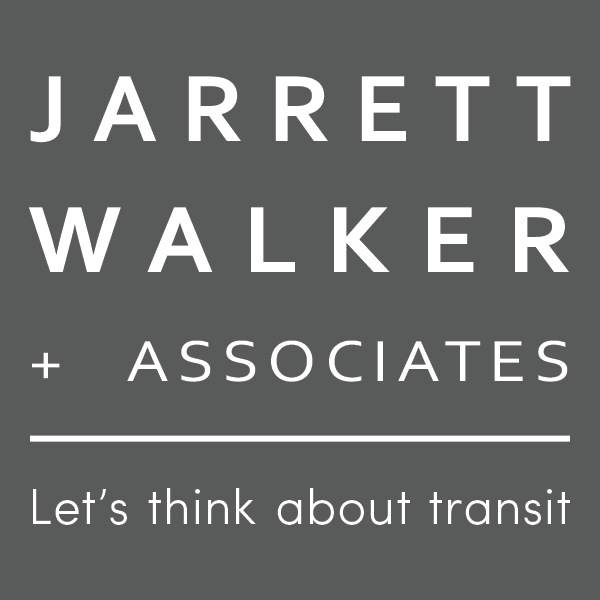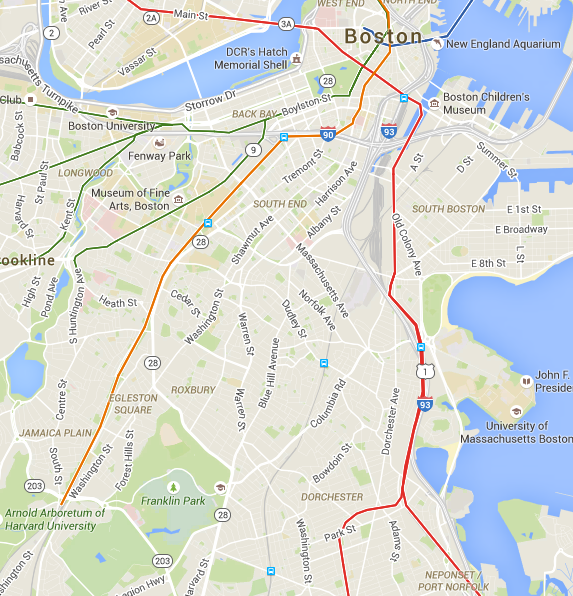Antonio Loro is an urban planner who focuses on the planning implications of emerging road vehicle automation technologies. He has conducted research with TransLink and Metrolinx on the potential impacts of automated vehicles, and is currently with the Ministry of Transportation of Ontario. This article was written by Antonio Loro in his personal capacity. The views expressed in this article are the author's own and do not necessarily represent the views of the previously mentioned organizations.
As efforts to develop automated vehicles continue to speed forward, researchers have begun to explore how driverless taxis in particular could play a prominent role in the future mix of urban transportation options. Some of these early findings raise the provocative argument that driverless taxis (or self-driving or fully-automated taxis, if you prefer) could hugely reduce or even eliminate the need for buses and trains. However, careful interpretation of this research reveals that vehicles with high passenger capacities (bus and rail transit, in other words) could be superseded by lower-capacity vehicles only where there is plenty of road space to spare. Where road lanes are in shorter supply, buses and trains – which could themselves get a huge productivity boost from automation – will continue to be indispensable for moving large volumes of passengers. In such cases, driverless taxis, especially share taxis, will be ideally suited to complement higher-capacity transit, generally by focusing on areas with a surplus of road space. And in the near-term, even before such advanced automation is perfected, automated buses could start improving mobility for large numbers of urban travelers.
Researchers have begun to explore future scenarios where vehicle automation technologies have advanced to a level that enables taxis to drive without human intervention through the full network of urban roads. Recently, the ITF (International Transport Forum), a think tank within the OECD, modeled a number of scenarios to examine how these driverless taxis, once they are commonplace, could serve urban travelers on a typical weekday in Lisbon. Among the outputs of their model, one is particularly attention-grabbing: even in a scenario where 8% of trips go by foot or bike, none go by transit, and the remaining 92% go by driverless taxis that serve single passengers, ITF researchers say that the number of taxis needed would be less than a quarter of the number of cars currently in use in the Portuguese capital. Such a reduction in the size of the overall fleet of cars in the city would greatly diminish parking demand. Unsurprisingly, though, in order to serve so many trips, the fleet of taxis would be used very intensively, and the total vehicle kilometres traveled (VKT) in the city would more than double.
Remarkably, the ITF team say that despite the upsurge in VKT in this scenario, travel times would be slowed very little. Underpinning this result is a noteworthy assumption in the model: currently, according to the ITF researchers, less than 40% of available capacity on Lisbon’s roads is in use during peak periods. (The authors caution that their figures are underestimates, as they do not account for bus travel, which makes up 13% of VKT in Lisbon.) The upshot is that even in a scenario where new taxi trips and empty taxis driving to their next passengers cause VKT to double, the ITF model’s outputs suggest that there should be road capacity to spare.
The model shows the previously very lightly used local roads absorbing much of the new VKT. Meanwhile, the most heavily traveled category of roads (“local traffic distributor roads”) rises from 43% to 69% of road capacity used. That 69% doesn’t necessarily mean traffic will be flowing smoothly, however. These percentages refer to the average capacity in use on different categories of roads – even if there is a low percentage of capacity in use on a given category of road, there could nevertheless be congestion focused at some locations on those roads. Interestingly, according to the TomTom Traffic Index, congestion may already be an issue in Lisbon, as travel times during peak periods are currently 45% to 70% longer than they would be under free-flow conditions.
The crucial implication to highlight here is that single-passenger driverless taxis could supplant buses and trains – but only where the roads have the capacity to absorb potentially huge increases in traffic without becoming congested.
A 2014 study by the Singapore-MIT Alliance for Research and Technology (SMART) arrived at results similar to those in the ITF study, though the SMART team modeled travel speeds in a much simpler way. The SMART researchers examined a scenario with single-passenger driverless taxis (or car-share vehicles) serving all trips in Singapore. They concluded that a fleet sized at one-third of the total number of passenger vehicles currently in use in the city could serve all trips while keeping peak period waiting times for the average passenger under 15 minutes. Such a dramatic result follows from a simplifying assumption in the model: the SMART team first estimated the current average speed that taxis drive at – including both the denser and the more dispersed areas of the city – and then assumed that future driverless taxis would drive at that particular speed, regardless of their location in the road network.
Less optimistically, the taxis would be bogged down in congestion of their own making. Currently in Singapore, 63% of peak period trips go via public transit. Shifting all of those trips to taxis would generate an abundance of new VKT – including VKT produced by empty taxis moving to their next passengers. Currently, peak period travel times on Singapore’s roads are 50% to 80% longer than they would be under free-flow conditions, according to TomTom; a massive increase in VKT wouldn’t help much.
A more recent article from the SMART team includes a brief exploration of the congestion effects of empty taxis repositioning themselves in a very simple road network. They find that their algorithm generally results in the empty vehicles traveling mainly on less busy roads, though the repositioning process could cause heavy congestion in networks where there is already congestion. This preliminary analysis suggests that much of the traffic produced by driverless taxi repositioning could be focused on the roads that are least congested to begin with. This suggestion lines up with the results of the ITF team. Interestingly, the ITF’s model of Lisbon has the biggest increases in traffic showing up on local streets in particular – which could unfortunately make them less attractive places to live, the authors caution. Such streets serve purposes other than being conduits for cars – they may be quiet routes for walking and cycling, or safe places for children to play, or inviting public spaces, for example – so injecting new car traffic could produce impacts other than congestion that are worth considering. Furthermore, while the SMART team suggests that much of the traffic created by repositioning per se might be focused on the roads that were previously least congested, the taxis that are actually carrying passengers could of course be the more important source of congestion – especially when large mode shifts, such as those seen in the scenarios described above, inevitably produce large VKT increases.
The ability of automated vehicles to use roads more efficiently could mitigate congestion resulting from increased VKT – with some caveats. Combining automation and V2V (vehicle-to-vehicle communication) technologies would enable vehicles to drive safely with short following gaps. However, the large potential capacity increases resulting from this “platooning”, where vehicles are grouped into closely-packed files, would mainly materialize on freeways, where traffic flows are less turbulent than on city streets. Automation with V2V could also boost flows through intersections by coordinating the movements of vehicles far more efficiently than traffic signals. These improvements would be constrained, though, wherever intersections are shared with entities not equipped with the requisite tech – not just cars, but pedestrians and cyclists as well. More radically, vehicles themselves could be smaller, thus occupying less road space, if the crash avoidance capabilities of automation eliminate the need for bulky, crashworthy construction. However, such a revolution in vehicle design would not be able to take over the streets until automation technologies are advanced enough and adopted widely enough to guarantee occupant safety.
The capacity limits of roads could be less of an impediment for multi-passenger driverless taxis. Hypothetically, if 8% of trips in Lisbon were taken on foot or bike and the remaining 92% were served by driverless taxis carrying multiple passengers (most commonly three to five, but as many as eight), the ITF team estimates peak period VKT would rise by 25%. It’s a substantial increase, but much smaller than the 103% jump in the single-passenger taxi scenario discussed above. Not surprisingly, providing public transit service would further mitigate VKT. In a scenario where 22% of trips go by subway, 8% go by foot or bike, and the remaining 70% go by driverless share taxi, the model estimates peak period VKT would rise by a relatively modest 9%.
Taxis serving multiple rather than single passengers would also mean an even smaller taxi fleet would suffice. Fewer cars in the city, kept busy serving dozens of trips a day, would drastically cut the need for parking. Sidewalks and bike lanes would be among the potential uses for the freed-up land. If taxi passengers share rides, and if 22% of trips go by public transit, the ITF figures that close to 95% of all parking spaces in Lisbon could be made redundant. (This outcome depends on traffic still flowing smoothly despite a 9% increase in VKT – if traffic is slowed, a larger taxi fleet would be needed to effectively serve all trips, so more parking would be needed during periods of low demand).
The discussion above just scratches the surface of the ITF and SMART studies – it’s definitely worth reading the original articles to explore their insights and to understand how the models were constructed. Higher-fidelity models that build on the ITF and SMART efforts will improve our estimates of the potential for driverless taxis to serve urban trips; however, even without complex models, it is clear that automation won’t eliminate the need for buses and trains when large numbers of people have to move through limited space. This is one of the straightforward geometric arguments that Jarrett has made before in this blog: larger vehicles fit more people into a given length and width of right-of-way than convoys of small vehicles can carry. (To illustrate, a freeway lane might have a capacity as high as 2400 cars per hour, while Bogotá’s TransMilenio bus rapid transit system has a capacity of 45,000 people per hour per direction.)
Of course, it’s a contentious question when we will attain the holy grail of automation technology sufficiently sophisticated to enable taxis or other vehicles to drive on any road in any conditions. It may appear further in the future than some suppose; nevertheless, even before this “Level 5” technology (as defined by the Society of Automotive Engineers) is mature, there will be vehicles capable of fully automated operation under more restricted conditions. There already are – such “Level 4” vehicles are currently capable of driving themselves at low speeds when segregated from challenging traffic environments. Beginning in the near-term, these kinds of low-speed automated vehicles, perhaps looking something like Google’s famously cute prototype, could carry passengers in settings like retirement communities. They could also circulate through networks of low-speed roads in suburban neighbourhoods or business parks to provide “first and last mile” access to and from transit routes.
 Both in the near-term and the long-term, one of the most effective ways to reap the mobility benefits of automation will be to apply it to buses. Even with current technology, driverless operation would be feasible for buses running on busways with adequate exclusion of other vehicles and potential hazards. And even for buses on streets with mixed traffic, some of the technical challenges of achieving full automation are eased. For example, since bus routes run along only a small subset of the larger urban road network, the challenges of building and maintaining exquisitely detailed, meticulously annotated, continually updated maps would be substantially reduced – this would be advantageous for mapping-reliant approaches to automated driving, such as Google’s approach. The drop in labour costs from automation would enable dramatically increased frequencies, and the precision of automated control could also improve reliability. Because of the imminent potential to significantly improve mobility for large numbers of travelers, buses are a key priority for the application of automation.
Both in the near-term and the long-term, one of the most effective ways to reap the mobility benefits of automation will be to apply it to buses. Even with current technology, driverless operation would be feasible for buses running on busways with adequate exclusion of other vehicles and potential hazards. And even for buses on streets with mixed traffic, some of the technical challenges of achieving full automation are eased. For example, since bus routes run along only a small subset of the larger urban road network, the challenges of building and maintaining exquisitely detailed, meticulously annotated, continually updated maps would be substantially reduced – this would be advantageous for mapping-reliant approaches to automated driving, such as Google’s approach. The drop in labour costs from automation would enable dramatically increased frequencies, and the precision of automated control could also improve reliability. Because of the imminent potential to significantly improve mobility for large numbers of travelers, buses are a key priority for the application of automation.
With Level 5 automation, driverless taxis would become feasible. But rather than usurping the place of buses, they could play a complementary role. Level 5 would of course expand the domain of driverless buses, enabling them to provide service on any road; but it’s simply because buses can move numerous passengers in little road space that they will remain indispensable. Buses could ply heavily traveled corridors; driverless taxis could operate in less dense areas and during periods of lighter travel, whether serving complete trips or feeding into bus and train networks.
Interestingly, since low labour costs for driverless buses would enable higher frequencies, smaller vehicles would suffice to provide effective service in some areas. At a certain point, it could be difficult to distinguish in appearance between a small driverless bus and a driverless share taxi. However, their functions could be distinct: for example, driverless buses could provide frequent, predictable service on fixed routes according to schedules or headways, and driverless share taxis could provide on-demand, flexible route service. On the other hand, because diverting routes to pick up and drop off multiple passengers at numerous origins and destinations would cut into the travel time and cost benefits of taxi travel, some driverless share taxis could end up providing service with more fixed routing.
The take-home message from all this is that it’s critical to strategically deploy vehicle automation technologies according to their strengths and weaknesses. At some point, Level 5 automation will be achieved and driverless taxis will become feasible – but it’s important to think beyond just driverless taxis. To create the best possible mix of urban transportation options, it’s essential to consider the advantages and disadvantages of a range of potential automated vehicles and services – including buses, driverless taxis, and low-speed vehicles. Even more important, there's no need to wait for a Level 5 world with fully-fledged driverless taxis to appear before reaping the benefits of automation – and transit agencies have an opportunity to take the lead.
[My thoughts on this piece are at the top of the comments! — Jarrett]
Photo: Rotterdam driverless bus prototype, 2getthere.eu


